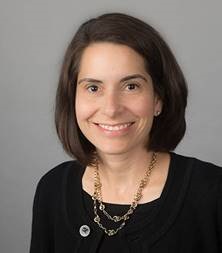Dr. Ana Tuya Fulton has been named Care New England Health System’s chief population health officer, adding to her list of titles, which includes executive chief of geriatrics and palliative care at CNE, as well as chief medical officer of Integra Community Care Network.
Fulton, a geriatrician, will help lead efforts to establish value-based care at CNE in an effort to make its care more effective and less expensive. She discusses her new position and the benefits that she is hoping patients will experience from her work.
PBN: Is the role of chief population health officer a new one for Care New England? And what will your main responsibilities be in the position?
FULTON: The designated role and title are new, but the functions are ones that Dr. James E. Fanale, in his capacity as the president and CEO of CNE, has been doing for the duration of his time at CNE. His vision started the journey for population health at CNE with the formation of the Integra accountable care organization. I’ve been fortunate to be involved in that work since the start of the Integra ACO in 2015. He created this new, formal position to ensure that the important population health efforts at CNE and the innovation and strategy work continue after his retirement in 2023.
As the chief population health officer, a major role is to provide strategic direction and oversight to build and expand programs that foster wellness and patient-centered care, strengthen collaborations with health plans, other systems of care and to foster collaboration with Brown University’s School of Public Health and WAMS [Warren Alpert Medical School]. Another important goal will be to work with key regulatory bodies to support the efforts to reduce cost trends in health care across Rhode Island and to work to improve the quality, access, service and equity in CNE and beyond.
A main responsibility that I am especially excited about will be to oversee the creation of new programs to continue to advance innovation and population-based strategies and the expansion of innovative models of care such as advanced primary care, Age-Friendly health care and hospital at home. Bringing such programs to all Rhode Islanders is a key responsibility of this role.
PBN: Are there any priorities you have in mind as you move into this role?
FULTON: Yes, first and foremost my priority will be to develop a better understanding of the populations we care for across all sites in the health system and to collaborate with leaders at each of those sites to begin to choose priority areas and projects. Already we know that improving access to primary care and behavioral health will be a major focus of work and there are amazing efforts underway now that I look forward to participating in.
As a geriatrician, I am very focused on expanding Age-Friendly care across the health care system. We need to infuse the basic principles across the entire care continuum to better serve the rapidly growing population of older adults in Rhode Island.
Additionally, working to advocate for the ongoing support of hospital at home is important and something I’ll use this new role to do with more parties across our state so that this can be a program that is accessible to all Rhode Islanders who would want it.
Finally, I look forward to collaborations across our state, regionally and nationally to learn about innovative services and programs that we can bring to our state to improve our health care system and to strengthen community-based services to foster wellness.
PBN: How will your work as the head of population health directly affect patient care?
FULTON: If the work doesn’t have a direct effect on patients and their experience of health care, then it has failed; so, the goal is to have a direct impact. Ideally, the focus is to create a system that is designed around wellness, that focuses not just on treating illness but preventing it, and that when illness is present, focuses on delivering care that is patient centered, at the right time and in the right place to align with each patient’s individual needs.
Bending the cost curves will also bring savings directly to patients. Bringing in new programs and services that offer more options such as advancing telehealth, in-home care, advanced primary care practices with more robust interdisciplinary team support and integrated models of care with behavioral health, geriatrics and palliative care are also ones that can help better serve patients and families in our communities.
Additionally, making sure our system understands the whole patient is a key tenant we are working hard to become better at. We are seeking to capture our patients’ race, ethnicity and language preferences so we can honor those differences and provide care in their preferred language that is culturally sensitive. We also understand that social determinants, living situations, social supports and food or housing insecurity directly affect health and wellness, so asking about those areas and making sure we help each patient who wants or needs support is extremely important.
All of these things are directly related to the work CNE has started and will continue to expand on, and all of this work should bring our patients and their families and caregivers improved satisfaction with care, improved wellness and better health outcomes.
PBN: Is there a collaborative aspect between your new role and your oversight of geriatrics and palliative care at CNE? Are the two issues intertwined?
FULTON: Absolutely. The emergence of value-based models of care has brought increased attention to improving coordination and quality, while reducing unnecessary procedures and increasing attention to quality of life and patient-centered, individualized care. These principles are foundational to the fields of geriatric medicine and palliative care.
Additionally, this atmosphere of change is well suited to advancing models of care that are designed for older adults’ and those with serious illnesses’ specialized needs, since those needs naturally fit these new priorities. Working within systems that are innovating and using alternative payment models to change incentives and drive change is exciting as a geriatrician and having the background of caring for complex patients with multiple conditions, medications and medical, social and behavioral needs is a skill set that has served me well to operate in the world of value-based models.
At CNE, we see advancing primary care with the support of geriatrics and palliative care as a key mission and core value. Some examples of the types of programs that align with this mission and value are infusing the importance of “what matters” to our patients throughout our work; to truly deliver patient-centered care, we need to ask our patients what’s important to them, what are their goals when they seek care?
Expanding options for sites of care is another example, bringing care to the home, either virtually or in person, has been immensely helpful to better meet the needs and goals of some of our most complex patients. We’ve learned that delivering acute care at home can provide higher satisfaction and similar, if not better, clinical outcomes for eligible patients, and it is something our patients, particularly our older adults, have been asking for and want more of.
PBN: What sort of savings could a value-based care system potentially mean for both Care New England and its patients?
FULTON: Changing the incentives and payment models allows the health care system to move away from the traditional numbers-based approach and gives flexibility to the system to use the shared savings to stand up new programs that foster prevention and wellness, or that work to improve quality and outcomes.
Savings to the health plans and delivery systems can help further investments in programs that improve access using technology such as robust patient facing platforms, remote monitoring programs and telehealth options that allow patients to seek care in ways that are more flexible and better fit their lifestyle.
Innovation and tests of change can more readily happen in this environment and programs can start with more time to show their impact when the focus is off revenue and more on outcomes of care and satisfaction by the consumers of these programs, our valued patients and their families.
If we can bend the health care cost trends, the savings to our state, systems, patients and health plans can be moved upstream to support wellness and to invest in programs that support and improve the social determinants of health in our communities. For many patients and families, savings on health care-related costs will benefit them immensely and allow them to use the savings on other important needs for their physical, mental health and quality of life.
This is probably the single most important benefit and purpose of having a strong population health focus.
Elizabeth Graham is a PBN contributing writer.













